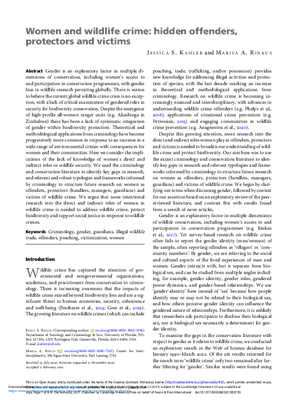Women and wildlife crime: hidden offenders, protectors and victims
Gender is an explanatory factor in multiple dimensions of conservation, including women's access to and participation in conservation programmes, with gender bias in wildlife research persisting globally. There is reason to believe the current global wildlife crime crisis is no exception, with a lack of critical examination of gendered roles in security for biodiversity conservation. Despite the emergence of high-profile all-women ranger units (e.g. Akashinga in Zimbabwe) there has been a lack of systematic integration of gender within biodiversity protection. Theoretical and methodological applications from criminology have become progressively more common in response to an increase in a wide range of environmental crimes with consequences for women and their communities. Here we consider the implications of the lack of knowledge of women's direct and indirect roles in wildlife security. We used the criminology and conservation literature to identify key gaps in research, and relevant and robust typologies and frameworks informed by criminology to structure future research on women as offenders, protectors (handlers, managers, guardians) and victims of wildlife crime. We argue that more intentional research into the direct and indirect roles of women in wildlife crime is needed to address wildlife crime, protect biodiversity and support social justice in response to wildlife crimes.
https://biodiversitylinks.org/learning-evidence/wild-meat-collaborative-learning-group/evidence-collection/evidence-inbox/women-and-wildlife-crime-hidden-offenders-protectors-and-victims.pdf/view
https://biodiversitylinks.org/learning-evidence/wild-meat-collaborative-learning-group/evidence-collection/evidence-inbox/women-and-wildlife-crime-hidden-offenders-protectors-and-victims.pdf/@@download/image/image.png
File
Women and wildlife crime: hidden offenders, protectors and victims
Author(s):
Kahler, Jessica S
,
Rinkus, Marisa A
Publication Date: 2021
Location: Global
DOWNLOAD FILE
Gender is an explanatory factor in multiple dimensions of conservation, including women's access to and participation in conservation programmes, with gender bias in wildlife research persisting globally. There is reason to believe the current global wildlife crime crisis is no exception, with a lack of critical examination of gendered roles in security for biodiversity conservation. Despite the emergence of high-profile all-women ranger units (e.g. Akashinga in Zimbabwe) there has been a lack of systematic integration of gender within biodiversity protection. Theoretical and methodological applications from criminology have become progressively more common in response to an increase in a wide range of environmental crimes with consequences for women and their communities. Here we consider the implications of the lack of knowledge of women's direct and indirect roles in wildlife security. We used the criminology and conservation literature to identify key gaps in research, and relevant and robust typologies and frameworks informed by criminology to structure future research on women as offenders, protectors (handlers, managers, guardians) and victims of wildlife crime. We argue that more intentional research into the direct and indirect roles of women in wildlife crime is needed to address wildlife crime, protect biodiversity and support social justice in response to wildlife crimes.


